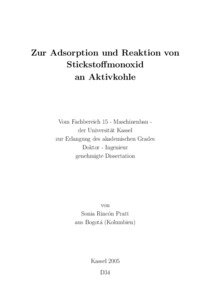| dc.date.accessioned | 2006-05-19T07:59:13Z | |
| dc.date.available | 2006-05-19T07:59:13Z | |
| dc.date.issued | 2005-11-16 | |
| dc.identifier.uri | urn:nbn:de:hebis:34-2908 | |
| dc.identifier.uri | http://hdl.handle.net/123456789/2908 | |
| dc.format.extent | 2536321 bytes | |
| dc.format.mimetype | application/pdf | |
| dc.language.iso | ger | |
| dc.rights | Urheberrechtlich geschützt | |
| dc.rights.uri | https://rightsstatements.org/page/InC/1.0/ | |
| dc.subject | Ölpalmschalen | ger |
| dc.subject | adsorption | eng |
| dc.subject | activated carbon | eng |
| dc.subject | nitrogen monoxide | eng |
| dc.subject | fix bed reactor | eng |
| dc.subject.ddc | 660 | |
| dc.title | Zur Adsorption und Reaktion von Stickstoffmonoxid an Aktivkohle | ger |
| dc.type | Dissertation | |
| dcterms.abstract | Die Verwendung von Aktivkohlen und -koksen stellt eine Alternative zu herkömmlichen Prozessen zur Verminderung der NOx-Emissionen in Rauchgasen dar. An diesen Materialien wird Stickstoffmonoxid adsorbiert und katalytisch zu N2 reduziert. Eine einheitliche Erklärung über die ablaufenden Vorgänge und die Reaktionsmechanismen gibt es noch nicht. Die Ergebnisse der bisher veröffentlichten wissenschaftlichen Arbeiten sind sehr unterschiedlich, wenn nicht sogar widersprüchlich. In dieser Arbeit wird, anhand der Messung von NO-Durchbruchskurven und thermischen Desorptionsspektren, die Adsorption und Reaktion von Stickstoffmonoxid an Aktivkohlen und -koksen in Anwesenheit von Sauerstoff und Wasserdampf untersucht. Zur Durchführung der experimentellen Untersuchungen wird eine Versuchsanlage, bestehend aus einer Vorrichtung zur Gasgemischaufbereitung, einem Festbettreaktor und einer Gasanalytik, konzipiert und aufgebaut. Die Untersuchungen erfolgen bei Temperaturen zwischen 100 und 150 °C. Die NO-, O2- und H2O-Konzentrationen werden anhand der Rauchgaszusammensetzung kohlegefeuerter Kraftwerke gewählt. Die experimentellen Untersuchungen konzentrieren sich auf die Verwendung einer Aktivkohle aus Ölpalmschalen, die in einem Drehrohrreaktor am Institut für Thermische Energietechnik der Universität Kassel hergestellt wurde. Die experimentellen Ergebnisse zeigen, dass während des Prozesses NO-Adsorption, -Reduktion und -Oxidation, NO2-Bildung, -Adsorption und -reduktive Desorption, H2O-Adsorption sowie O2-Vergasung gleichzeitig stattfinden. Bei niedrigen Temperaturen werden die NO2-Bildung und die Adsorption bevorzugt. Die NO-Reduktion läuft über adsorbiertes NO mit CO2- und CO-Bildung. Durch O2-Vergasung werden aktive freie Cf-Plätzen für die NO-Reaktion und -Adsorption gebildet. Wasserdampf wird an der Aktivkohle adsorbiert und belegt aktive Plätze für diese Prozesse. Aus den experimentellen Ergebnissen werden kinetische und Gleichgewichtsparameter der NO-Sorption bestimmt. Ein vereinfachtes mathematisches Modell des Festbettreaktors, das zur Berechnung der NO-Durchbruchskurven bei unterschiedlichen Temperaturen dient, wird aufgestellt. | ger |
| dcterms.abstract | The use of activated carbon and activated coke offers an alternative to conventional processes for the reduction of the emissions of nitrogen monoxide from flue gas. Adsorption and catalytic reduction of nitrogen monoxide occurs simultaneously on these materials. Since the results from published work are very variable or even contradictory, there is not at present a consistent explanation of the reactions and reaction mechanisms taking place during the processes. On this work the adsorption and reaction of nitrogen monoxide on activated carbon and activated coke in presence of oxygen and water vapor is investigated. The investigation is carried out on the basis of the measurement of breakthrough curves and thermal desorption spectra. For the execution of the experimental work a pilot plant composed of a device for the preparation of the gas mixture, a fix bed reactor and a gas analysis system was designed and constructed. The experiments are made at temperatures between 100 and 150 °C. The concentrations of NO, O2 and H2O correspond to the composition of the flue gas from coal fired power plants. The experimental work focus on the use of an activated carbon from oil palm shells, which were produced in a rotary kiln at the Institut for Thermal Engineering at the University of Kassel. The experimental results show, that during the process occurs simultaneously adsorption, reduction and oxidation of NO; formation, adsorption and reductive desorption of NO2, adsorption of H2O and gasification mit O2. The creation of NO2 and the adsorption process are at low temperature favoured. The reduction of NO takes place over adsorbed NO with formation of CO2 and CO. Through O2 gasifcation free active Cf sites for the reaction and adsorption of NO are formed. Water vapor adsorbs on the activated carbon and occupies active sites for the processess. From the experimental work kinetic and equilibrium parameters from the sorption of NO are determined. A simplified mathematical model of the fix bed adsorber, which calculates NO breakthrough curves at different temperatures is developed. | eng |
| dcterms.accessRights | open access | |
| dcterms.creator | Rincón Pratt, Sonia | |
| dc.contributor.corporatename | Kassel, Universität, FB 15, Maschinenbau | |
| dc.contributor.referee | Klose, Wolfgang (Prof. Dr.-Ing.) | |
| dc.contributor.referee | Heek, Karl-Heinrich van (Prof. Dr.) | |
| dc.subject.swd | Adsorption | ger |
| dc.subject.swd | Aktivkohle | ger |
| dc.subject.swd | Stickstoffmonoxid | ger |
| dc.subject.swd | Festbettreaktor | ger |
| dc.subject.swd | Rauchgasreinigung | ger |
| dc.subject.swd | Reaktionsmechanismus | ger |
| dc.subject.swd | Prozessmodell | ger |
| dc.date.examination | 2005-06-17 | |

